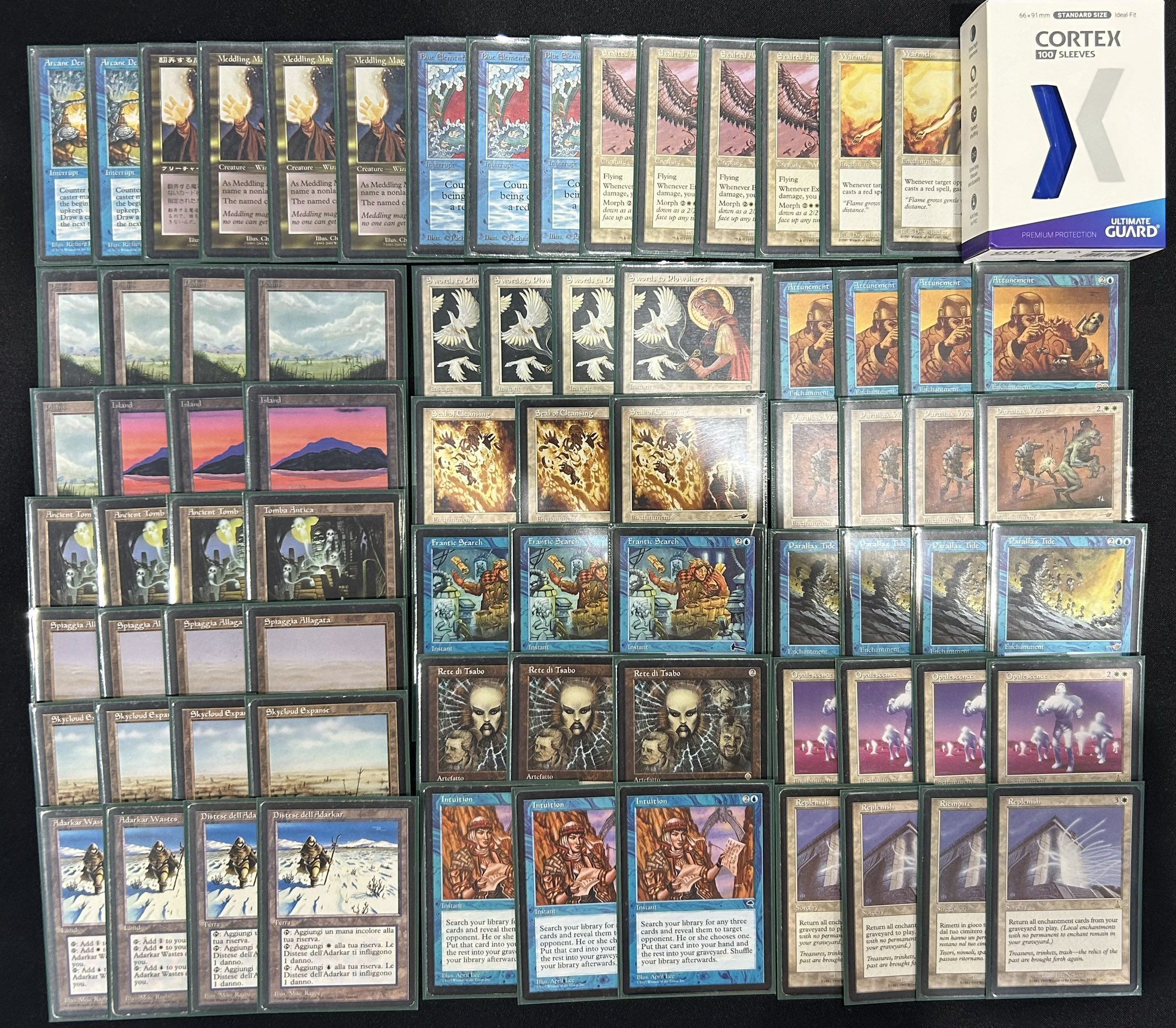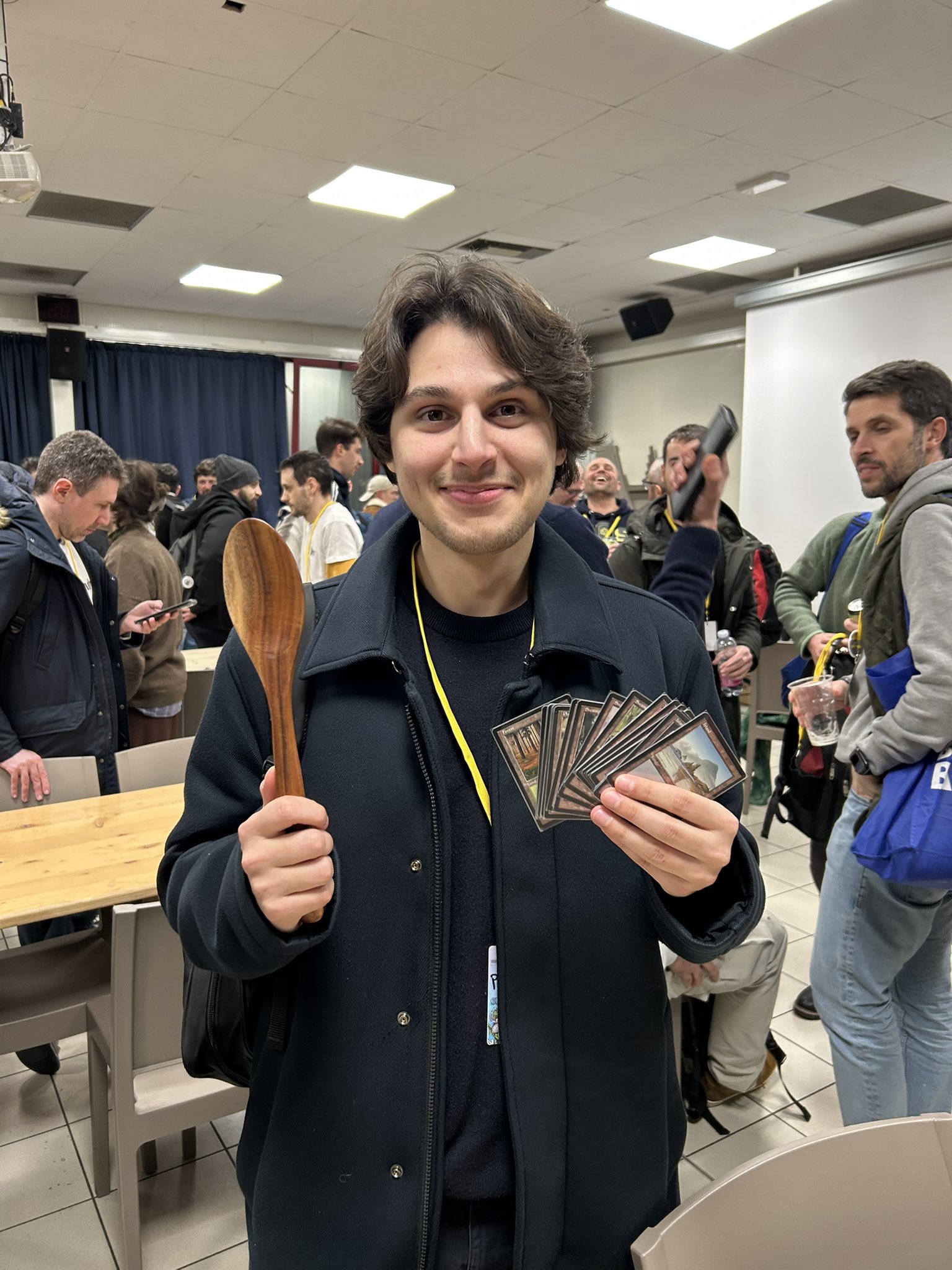Loading...
Products
Magic: The Gathering Line
Deck Box Type
A few weeks ago, during the Four Seasons event—a well-known Italian tournament series that hosts "old" formats—I was introduced to Premodern by my friend Mengu, who was sleeving his Tempest Intuitions. Curious to see the format in action, I wandered around the tables, and the vibes were immaculate. Phyrexian Dreadnought facing off against Vindicate, lethal Psychatogs and Goblin Lackeys, Akroma, Angel of Wrath flipping into play with Oath of Druids against a mono-red player—it was a spectacle!
At this point, I know what you’re thinking. But no, I’m not an MTG boomer—I’m 26 and wasn’t even born when Mirage was printed. I appreciate the variety Magic offers, from exploring different cards to embracing its evolution into a gathering of all nerd cultures, where you can mix your love for Evil Dead and Transformers. But I also value the existence of "safe havens" like Premodern, where players can enjoy a format that feels "broken" in the best way—much like Old School—but without an absurd price tag, all while preserving the original Magic experience in gameplay, art, and deckbuilding.
Let’s start to explore the positive and negative points of this community format.
In Premodern, you can play all cards from Fourth Edition to Scourge, with a unique ban list curated by Martin Berlin, the creator of the format. While there are plenty of resources to browse decklists, I feel the format is still deeply underexplored, with some strategies yet to be fully developed. Sure, there are obvious "broken" cards like Survival of the Fittest and Phyrexian Dreadnought, but other, more subtle interactions remain untapped.
Broadly speaking, the best decks in the format are:
The best tempo deck I’ve ever played. It runs plenty of cantrips, along with Gush and Foil for card advantage, allowing you to protect your threats while digging for the game-winning combo. At its core, it revolves around a simple yet devastating two-card, two-mana synergy (Stifle + Phyrexian Dreadnought) that can take over the game in an instant.
This deck takes full advantage of one of the best toolbox engines in Magic history: Survival of the Fittest. Playing a more controlling role in the early game, it eventually assembles a one-turn-kill combo with Recurring Nightmare. Thanks to Survival, the deck has access to flexible silver bullets like Nantuko Vigilante and Withered Wretch, giving it the tools to shut down unfair strategies.
A hybrid control-combo deck that fills the graveyard with powerful enchantments like Parallax Tide and Parallax Wave, then brings them back with Replenish for massive value. It can play a grindy game with Swords to Plowshares and Seal of Cleansing or shift gears into a faster strategy, leveraging Intuition and Ancient Tomb to set up quick kills.
The classic aggressive red deck. Small, efficient creatures apply early pressure, while burn spells close out the game. And yes, turns out Ball Lightning is still as terrifying as ever!
Destroying lands is incredibly powerful in a slow format like Premodern. These decks, powered by Armageddon or Stone Rain, capitalize on that strategy while accelerating their plan with Mox Diamond. Terravore quickly becomes a massive threat, punishing opponents who struggle to rebuild their manabase.
But as I mentioned earlier, Premodern is a deep format, and the gap between Tier 1 decks and everything else isn’t as wide as you might expect—if it even exists at all. A great example is Academy Reanimator, piloted by Giuseppe Di Vincenzo to a Top 8 finish at the recent Italian Premodern Nationals. This deck blends Academy Rector’s powerful tutor effect with a Shallow Grave combo package, allowing it to operate on multiple axes and pivot as needed to win.
No matter what kind of player you are, I bet there’s a deck for you in Premodern. Love enchantments? Countermagic? Stax? The format has it all, and the best part—you can tailor your deck to play exactly how you want!
All top decks in Premodern share a few key traits:
One of the most common ways to disrupt opponents in Premodern is through land denial. Cards like Armageddon, Parallax Tide + Chain of Vapor, Winter Orb, Tangle Wire, and the ever-reliable Wasteland and Rishadan Port are all widely played across the format’s premier decks.
Counterspell is another powerhouse in this format, as most threats are more expensive than the classic UU instant. That said, simply having a strong, proactive aggressive strategy can often be enough to win a significant number of games in this slow format; that’s why Sligh is played so much and keeps doing well.
Artifacts and Enchantments are the most powerful spells in the format. Phyrexian Arena can win the game on its own, especially if played on turn one with Dark Ritual, but also unchecked Phyrexian Dreadnought or Survival of the Fittest are really problematic cards. That’s why a lot of decks - if not all of them - main deck Naturalize effects, in the form of Seal of Cleansing, Vindicate, Naturalize or just Chain of Vapor if you’re mono blue. If these cards are not in the main deck they appear in multiple copies in the sideboards, mixed with more specific cheap hate like Annul or Disenchant.
Knowing this is a main point of the format, what should an Enchantment Heavy deck like Replenish do to win postboard games, knowing about the huge denials all the deck have?

The answer is: playing a transformational sideboard plan! The idea of changing your deck's main focus in post-board games is not very common in other formats, primarily because the overall power level of individual cards is so high that switching strategies isn’t usually worth it. However, in Premodern, this approach is much more common—mainly because most decklists are created by players, making the element of surprise a real factor.
For instance, Blue Tide Control decks can sideboard into Phyrexian Dreadnought, and the reverse is also true. Similarly, playing a few copies of Brain Freeze or slotting in 12 creatures is a common strategy in unfair decks that are heavily hated out. But in Premodern, you can never be entirely sure what to expect—until someone taps three mana for a morph.
Wandering around the tables at the Italian Premodern Championship was a truly different experience from what I'm used to in an average MTG tournament. It felt like something magical was happening: even in defeat, players were genuinely happy to have fought a card battle and spent time together with others. One player won his first game in round five and announced it out loud, leading to a shared moment of laughter that culminated in applause. The prizes for the top 8 were far lower in value than those in the charity raffle held before the top 8. Since I finished ninth, they gave me a wooden spoon as a consolation prize.

I think a lot of this "chill and good vibe" comes from the freedom to play the cards you love because, no matter what you're doing, you're already enjoying your prize. Building your deck around Legacy Weapon or carefully selecting the perfect artwork for your basic lands to match your deck's theme enhances the "magic" experience by a huge margin.
1) Most of the cards aren’t cheap—they’re actually quite expensive
When I joined the format, I decided to play Stiflenought because the deck matches my vibe as a blue tempo player. I quickly discovered that a playset of Dreadnought alone costs almost as much as an entire Modern deck. This is also true for other key cards like Gaea’s Cradle, Survival of the Fittest, or Mox Diamond.
Additionally, as the format gains more popularity, card prices have started to rise. For example, Parallax Tide now costs at least $25, whereas just a couple of years ago, it was less than half that price.
One great thing about the format is that it allows gold-bordered cards, which are usually much cheaper than their regular-bordered counterparts. Still, the cost of entry for a new player can be quite high compared to other cool formats like Pauper.
The best advice I can give is to proxy your cards when playing with friends until you can afford a deck you truly like—and one you're unlikely to change. The format doesn’t rotate, and ban updates are infrequent. If you invest in "expensive cards," chances are they’re on the Reserved List, meaning you’ll likely recoup most of your money if you ever decide to sell them.
2) The format isn’t supported on Magic Online
Nowadays, Premodern has gained a lot of traction, and most major cities likely have at least one active league where you can play. However, if you live in the middle of nowhere (trust me, I get it—I live in Italy), finding regular games can be challenging, especially since the format isn’t supported on Magic Online.
Fortunately, you can find online leagues and playtest partners in various Premodern Discord communities. On MTGO, the cards are actually very cheap, and you can rent any deck using the lowest-tier option of a rental service.
I’m usually active and often create rooms in Freeform—hit me up if you want to play!

I want to thank my friends from the Milan and England Premodern scene, as well as the Chaos Orcs team, the organizers of the Italian Premodern Series.
And a huge hug to everyone helped me get into the format!